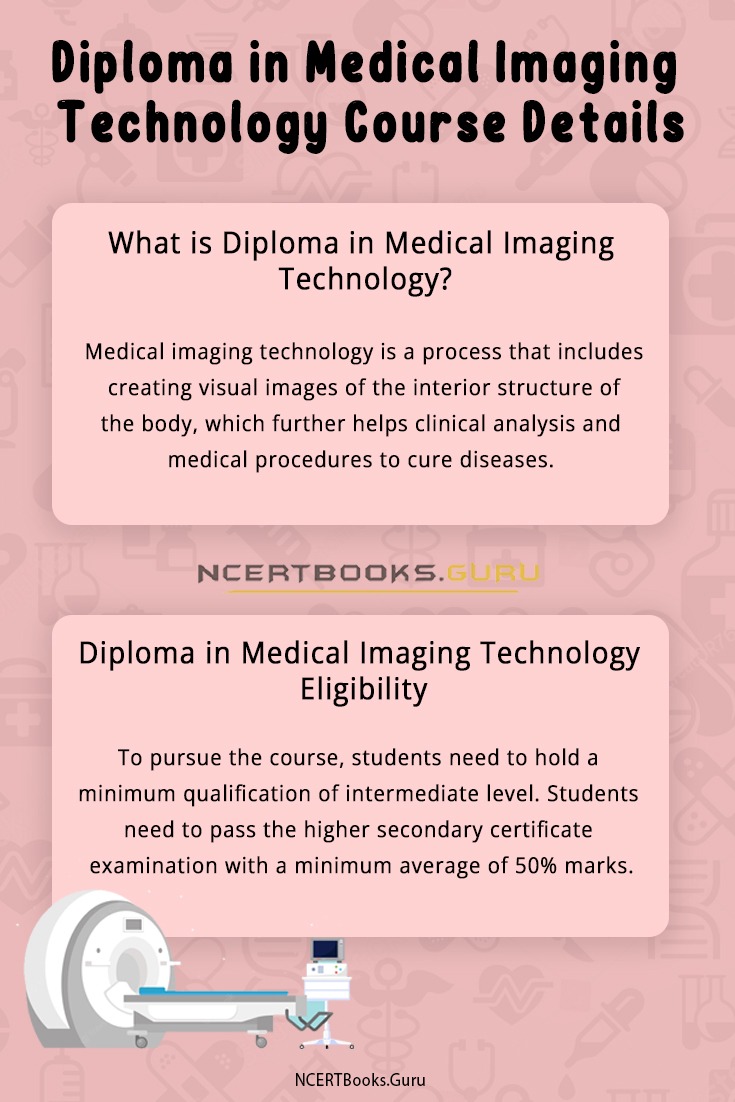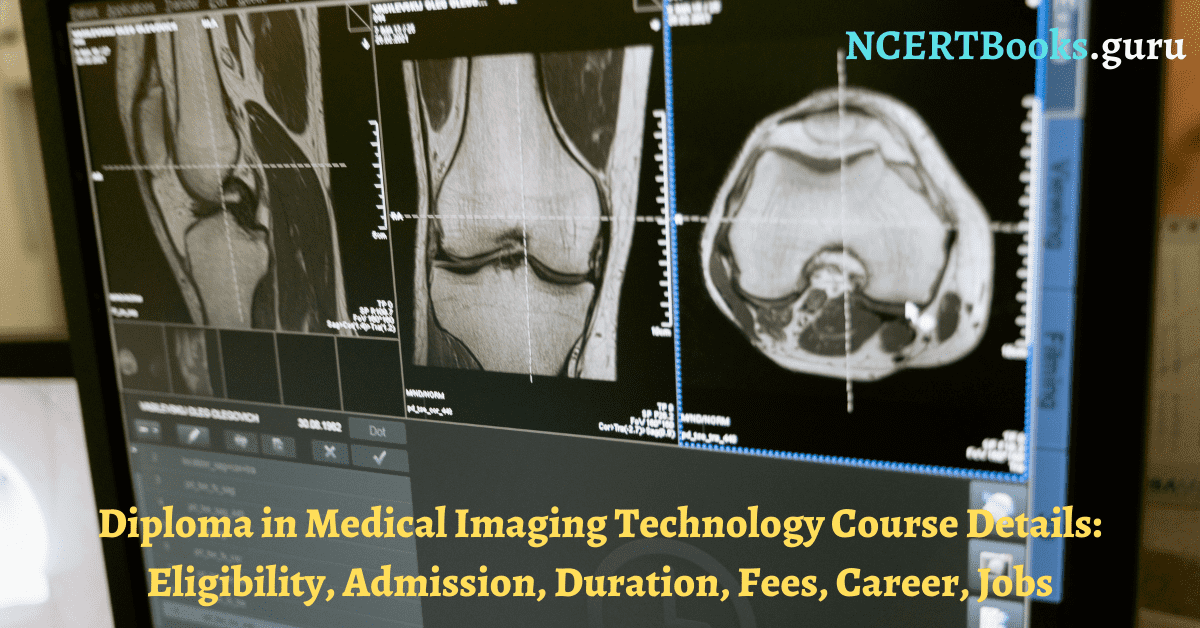Diploma in Medical Imaging Technology Course Details: Students who are interested in the medical sector can opt for this course. A diploma in Medical Imaging Technology will teach students about the different elements of traditional physics, patient positioning, X-rays, CT scan, C-arm, film processing and development, and diagnostic nuclear medicine.
- What is Diploma in Medical Imaging Technology?
- Diploma in Medical Imaging Technology Eligibility
- Medical Imaging Technology Diploma Entrance Exams
- DMIT Course Duration
- Diploma in Medical Imaging Technology Fees
- Diploma in Medical Imaging Technology Colleges
- Diploma in Medical Imaging Technology Course Syllabus
- Job Opportunities after Diploma in Medical Imaging Technology
- Diploma in Medical Imaging Technology Salary in India
- What can I do after diploma in imaging technology?
- What are the subjects in medical imaging technologies?
- What is the course duration of the Diploma in Medical Imaging Technology?
What is Diploma in Medical Imaging Technology?
Medical imaging technology is a process that includes creating visual images of the interior structure of the body, which further helps clinical analysis and medical procedures to cure diseases. The course offers a wide spectrum of knowledge and information in health sciences and biophysical, which enables the students to take over theory and practical. Thereby, training them to handle radio imaging equipment and processes. The course is filled with comprehensive learning with demonstrations, lectures, clinical and practical experiences.
Diploma in Medical Imaging Technology Eligibility
To pursue the course, students need to hold a minimum qualification of intermediate level. Students need to pass the higher secondary certificate examination with a minimum average of 50% marks.
Medical Imaging Technology Diploma Entrance Exams
There are two types of examinations for entrance:
- State-specific Entrance Examinations
- University-specific Entrance Examinations
The examination has to be attempted in the form of MCQs.
Syllabus
- Biology
- Chemistry
- Physics
- English Language and Comprehension
- Quantitative Reasoning
DMIT Course Duration
A diploma in Medical Imaging Technology can be completed in a span of 2 years. The course follows a semester pattern with a total of four semesters to be completed. Each year will have 2 semesters that last for a period of 6 months. Students have to qualify for the examination for each semester to successfully complete the diploma.
Diploma in Medical Imaging Technology Fees
The fees for Diploma Courses in Medical Imaging Technology range between INR 1 lakh- 1.5 lakhs.
Diploma in Medical Imaging Technology Colleges
Some of the popular colleges that offer the DMIT Course in India are listed for your reference. Select the college that better suits you and join to pursue your dream course.
- Bareilly International University, Bareilly
- Bhargavi Institute of Management and Technology, Hyderabad
- Kohinoor College of Paramedical Science, Mumbai
- Max Skill First, New Delhi
- Melmaruvathur Adhiparasakthi Institute of Medical Sciences and Research, Kancheepuram
- Oasis Institute of Health Sciences and Research Center, Pune
- Sanskriti University, Mathura
Diploma in Medical Imaging Technology Course Syllabus
DMIT Syllabus for all 2 Years is listed below. Know the Diploma in Medical Imaging Technology Subjects you need to cover as a part of your curriculum and prepare based on the weightage. Allot time to the topics of more weightage and prepare accordingly.
Diploma in Medical Imaging Technology Syllabus for 1st Year
Anatomy I
- Introduction of Bones of the Human Body
- Surface Markings of the Body
- Respiratory Organs
- Circulatory Organs
- Digestive Organs
- Joint and Functions
Physiology I
- Definition of Cell
- Structure and Functions the Cytoplasmic Organelles
- Reproduction
- The Important Physic-Chemical Laws Applied to Physiology
- Fundamentals of Different Organ Systems
Pathology
- Introduction of Pathology
- Immunity & Hypersensitivity
- Human Blood Group Antigens and Antibodies
- ABO Blood Group Systems
- Rh Blood Group System
- Erythroblastosis Faetalis
- Growth Disorders and Heoplasia
Generation and Properties of X-Ray
- Introduction
- Properties and Production of X-Ray
- Electric System in X-Ray
- Basic X-Ray Circuits Transformers Law
- Types Used in X-Ray Machine
- X-Ray Tubes
- Serial Radiography
- Tomography
- Iteration of X-Ray and Scatter Radiation
- Care and Maintenance of X-Ray Equipment
Radiation Hazards & Protection
- Introduction to Various Hazards
- Principle and Method of Protection
- Radiation Risk
- Biological Effects of Radiation
- Transport of Radiation Materials
- Radiation Emergencies
General Radiography
- Patents and Role of General Radiographer
- Regional Radiography
- Upper Limb and Lower Limb
- Hip and Pelvis
- Viertebral Column
- Chest and Adomen
- Skeletal Survey
Diploma in Medical Imaging Technology Syllabus for 2nd Year
Anatomy II
- Reproductive Organs
- Liver and Spleen Pancreas: Gall Bladder
- Excretory Organs
- Muscles
Physiology II
- Introduction of Physiology
- Formation of Different Type of Blood Cells
- Mechanism of Blood Clotting
- Cerebrospinal Fluid
- Specials Senses
General Radiography
- Special Procedure and Related Contrast Media
- Excretory System
- Oral Cholecystography
- Hystero Salpingography
- Angiography
- Soft Tissue Radiography
- Forensic Radiography
Mammography and Ultrasound Imaging
- Mammography
- Ultrasound
- Principle of Ultra Sound
- Types of Ultra Sound
- Role of Ultrasound in the Delivery Suite
CT Scan
- Basic Principle of CT Scan
- Equipment’s Description
- Conventional CT
- Computer Tomography
- Scanning Principle
- Image Reconstruction
- Sprial CT
MRI
- Basic Principle
- Instrumentation
- Principles of Magnetic Resonance Imaging
- Rapin Scan Techniques
- Spectroscopy
- Bioeffects and Safety
Also, find:
- Medical Transcription Course Details
- Paramedical Courses
- Diploma in Lab Technician Course
- Medical Diploma Course
- Medical Technologist Courses
Job Opportunities after Diploma in Medical Imaging Technology
After successfully completing the program, a student will be able to tackle projects in hospitals, medical labs, healthcare institutions, nursing home diagnostic centers, and research laboratories. The student has to pursue Radiology Courses to work as an Applications specialist for Equipment, Interventional Radiology Specialist, Medical Imaging technologist, Radiology information specialist, etc. Some of the other available jobs are as follows:
- Medical Imaging Technologist
- Application Specialist for Equipment
- Radiology Information Specialist
- Sonographer
- Interventional Radiology Specialist
- Magnetic Resonance Imaging Specialist
- Teacher/Lecturer
- Research Associate
- Medical Case Review Physician
- Patient Care Coordinator
- ECMO Technician
- Ultrasound Technician

Diploma in Medical Imaging Technology Salary in India
The salary starts from INR 10,000 to 15,000/-, depending on the experience and post of the candidate. The remuneration can rise up to INR. 2 Lakhs to 10 Lakhs p.a. as per experience.
Learn about different kinds of course details related information all under one destination and make the right career choice whether to go with it or not.
Diploma in Medical Imaging Technology Scope
Candidates who have finished studying the DMIT course can get job options in government as well as private companies. They can also go for higher studies such as graduate courses. Check different Short Term Courses in Medical Field that gives the highest salary.
FAQs on DMIT Course Details
1. What can I do after diploma in imaging technology?
After pursuing a Diploma in Medical Imaging Technology you can become a Radiologist, Radiographer, Ultrasound Technician/ Diagnostic Medical Sonographer, MRI Technician, CT Tech/ CAT Scan Technologist/ CT Scan Technologist.
2. What are the subjects in medical imaging technologies?
Diploma in Medical Imaging Technology Subjects include the following
- Anatomy
- Radiation Physics
- Pathology
- Radiographic Special Procedures and Patient Care
- Orthopaedics
- Radiographic Positioning
- Microbiology
- CT Imaging and Contrast Technique
3. What is the course duration of the Diploma in Medical Imaging Technology?
Diploma in Medical Imaging Technology lasts about 2 Years.
Conclusion
After successful completion of the Diploma in Medical Imaging Technology Course, a student can go for paramedical courses or opt for BSc. medical imaging technology. The student can take up a job as listed above or go for higher studies in any related medical field.
